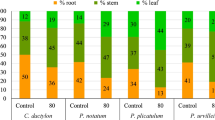Abstract
Proso grass was grown in pots in calcareous soils that received different levels of urea applied at seeding under very hot, dry conditions. Urea applications greater than 83 mg N kg/1 in one experiment and 130 mg N kg/1 in another caused severe toxicity to the grass seedlings. The toxicity corresponded to the period of active urea hydrolsis, 3–5 days from germination. At this time detectable NH4 in a low-and a high carbonate soil was equally far below that applied. A level of 40 mg NH4-N per kg soil appeared critical to seedling toxicity.
Similar content being viewed by others
References
Bremner JM (1965) In methods of Soil Analysis, part 2, Black CA, ed. Inorganic forms of nitrogen, pp: 1179–1237. Madison, Wisc American Society of Agronomy
Cook IJ (1962) Damage to plant roots caused by urea and anhydrous ammonia. Nature (Lond.) 194, 1262–63
Court MN, Stephen RC and Waid JS (1964) Toxicity as a cause of inefficiency of urea as a fertilizer. I Review J Soil Sci 15, 42–48
Cox WJ and Reisenauer HM (1973) Growth and ion uptake by wheat supplied nitrogen as nitrate, or ammonium, or both. Plant and Soil 38, 363–380
Frantz TA, Peterson DM and Durbin RD (1980) Ammonium accumulation in oat leaves incubated with methionine sulfoxinine or toxin from Pseudomonas coronafaciens. Agron. Abst. 72nd annual Meeting, Amer Soc Agron Publ: Madison, Wisc, USA
Goyal SS, Huffaker RC and Lorenz OA (1982) Inhibitory effects of ammonical nitrogen on growth of radish plants II. Investigation on the possible causes of ammonium toxicity to radish plants and its removal by nitrate. J Amer Soc Hort Sci 107, 130–135
Jorwekar AD, Shindae PB and Khanvikar G (1975) Effect of biuret content of urea on wheat. Indian J Agric Chem 8, 99–104
McElhannon WS and Mills HA (1977) The influence of nitrogen concentration and nitrate ammonia ratio on the growth of lima and snap bean and southern field pea seedlings. Commun Soil Sci Plant Anal 8, 677–687
McIntyre GJ and Hunter JH (1975) Some effects of the nitrogen supply on growth and development of Cirsium arvense. Can J Bot 53, 3012–21
Pierpont RA and Minotti PL (1977) Effect of Calcium Carbonate on ammonium assimilation by tomato. J Amer Soc Hort Sci 102, 20–23
Weil RR, Kroontje W and Jones GD (1979) Inorganic nitrogen and soluble salts in a Davidson clay loam used for poultry manure disposal, J Envir Qual 8, 86–91
Woltz SS and Jones JP (1973) Response of Manapal tomato seedlings to variations in inorganic nutrition. Proc 85th Ann Meeting Florida Sta Hort Soc Miami Beach, USA, 175–177
Author information
Authors and Affiliations
Rights and permissions
About this article
Cite this article
Ayed, I., Mashhady, A. The tolerance of a grass forage, grown in pots, to urea applied to calcareous soils under very hot, dry conditions. Fertilizer Research 5, 175–180 (1984). https://doi.org/10.1007/BF01052714
Accepted:
Issue Date:
DOI: https://doi.org/10.1007/BF01052714



